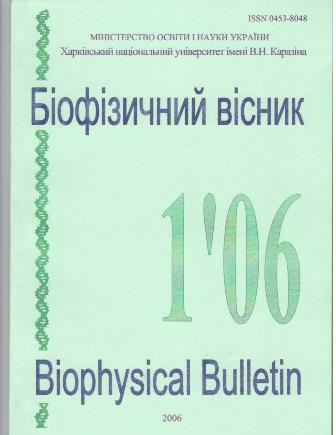Molecular mechanisms of structural relaxation of DNA kinks
Abstract
Molecular dynamics simulation and comparative analysis of the naked DNA structure and the DNA structure from purine repressor-DNA complex have been performed to study possible mechanisms of the relaxation of the deformations imposed on DNA in the complex, specifically, DNA kinking. The time evolution of both dinucleotide step parameters and the parameters that describe duplex configuration at higher levels (minor and major groove widths, end-to-end distance, etc) were analyzed. It was shown that the relaxation of the dinucleotide step kink occurs step-wise during relatively short time intervals. At the same time, such kink relaxation does not result in the straightening of the entire duplex; rather the bend is redistributed between several neighboring steps and the duplex remains in the bent configuration. The relaxation of the entire duplex occurs continuously and requires noticeably larger times. Thus, the obtained results allow us to conclude that the structural relaxation of the kink deformation imposed on DNA duplex occurs in stages, which are associated with different time scales.
Downloads
References
Olson WK, Gorin AA, Lu X-J, Hock LM, Zhurkin VB. DNA sequence dependent deformability deduced from protein-DNA crystal complexes. Proc. Nati. Acad. Sci. USA. 1998;95:11163-68.
Deremble C, Lavery R. Macromolecular recognition Curr. Opin. Struct. Biol. 2005;15:171-5.
Schumacher MA, Choi KY, Zalkin H, Brennan RG. Crystal structure of Lacl member, PurR, bound to DNA: minor groove binding by alpha helices. Science. 1994;266:763-70.
Kim YJ, Geiger H, Hahn S, Sigler PB. Crystal structure of a yeast TBP/TATA-box complex. Nature. 1193;365:512-20.
Love JJ, Li X, Case DA, Giese R, Grosschedl R, Wright PE. Structural basis for DNA bending by the architectural transcription factor LEF-1. Nature. 1995;376:791-5.
Travers AA. Reading the minor groove. Nature Struct. Biol. 1995;2:615-8.
Dickerson RE. DNA bending: the prevalence of kinkiness and the virtues of normality. Nucl. Acids Res. 1998;26:1906-26.
Bosch D, Campillo M, Pardo L. Binding of proteins to the minor groove of DNA: what are the structural and energetic determinants for kinking a basepair step? J. Comput. Chem. 2003;24:682-91.
Zacharias M. Minor groove deformability of DNA: a molecular dynamics free energy simulation study. Biophys. J 2006;91:882-91.
Murphy FV, Churchill ME. Nonsequence-specific DNA recognition: a structural perspective. Struct. Fold. Des. 2000;8:R83-9.
Glasfeld A, Kochler AN, Schumacher MA, Brennan RG. The role of lysine 55 in determining the specificity of the purine repressor for its operators through minor groove interactions. J. Mol. Biol. 1999;291:347-61.
Tolstorukov MY, Jernigan RL, Zhurkin VB. Protein-DNA hydrophobic recognition in the minor groove is facilitated by sugar switching. J. Mol. Biol. 2004;337:65-76.
Djuranovich D, Hartmann B. Molecular dynamics studies on free and bound targets of the bovine papillomavirus type I E2 protein: the protein binding effect of DNA and the recognition mechanism. Biophys. J. 2005;89:2542-51.
Lu X-J, Shakked Z, Olson WK. A-form conformational motifs in ligand-bound DNA structures. J. Mol. Biol. 2000;300(4):819-40.
El Hassan MA, Calladine CR. The assessment of the geometry of dinucleotide steps in double-helical DNA: a new local calculation scheme. J. Mol. Biol. 1995;251:648-64.
Newman EB, Lin R. Leucine-responsive regulatory protein: a global regulator of gene-expression in Escherichia coli. Annu Rev Microbiol. 1995;49:747-75.
Nelson M, Humphrey W, Gursoy A, Dalke A, Kalé L, Skeel RD, et al. NAMD - A Parallel, Object-Oriented Molecular Dynamics Program. J. Supercomputing App. 1996;10:251-68.
MacKerrel AD, Bashford D, Bellott M, Dunbrack RL, Evanseck J, Fried MJ, et al.. Self-consistent parameterization of biomolecules for molecular modeling and condensed phase simulations. FASEB J. 1992;6:A143.
Luty BA, Davis ME, Tironi IG, Vangunsteren WF. A comparison of particle-particle, particle-mesh and Ewald methods for calculating electrostatic interactions. Mol. Sim. 1994;14:11-20.
Feller SE, Zheng YH, Pastor RW, Brooks BR. Constant pressure molecular dynamics simulation-the Langevin piston method. J. Comp. Phys. 1995;103:4613-21.
Lu X-J, Olson WK. 3DNA: A software package for the analysis. rebuilding. and visualization of three-dimensional nucleic acid structure li Nucleic Acids Res. 2003;31(17):5108-21.
Dickerson RE. Definitions and nomenclature of nucleic acid structure parameters. J. Biomol. Struct. Dyn. 1989;6:627-34.
Olson WK, Lu X-J, Westbrook J, Bansal M, Burley SK, Dickerson RE, et al. A standard reference frame for the description of nucleic acid base-pair geometry. J. Mol. Biol. 2001;313:229-37.
Authors who publish with this journal agree to the following terms:
- Authors retain copyright and grant the journal right of first publication with the work simultaneously licensed under a Creative Commons Attribution License that allows others to share the work with an acknowledgement of the work's authorship and initial publication in this journal.
- Authors are able to enter into separate, additional contractual arrangements for the non-exclusive distribution of the journal's published version of the work (e.g., post it to an institutional repository or publish it in a book), with an acknowledgement of its initial publication in this journal.
- Authors are permitted and encouraged to post their work online (e.g., in institutional repositories or on their website) prior to and during the submission process, as it can lead to productive exchanges, as well as earlier and greater citation of published work (See The Effect of Open Access).





